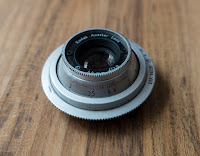Cost: $21 (average market price unknown)
This lens is a mystery. There is no posted information on this lens available. Even on websites listing all possible Soligor lenses, this one is missing from the list. There is plenty information on other Soligor 28-80mm lenses, but all with other apertures, with the 3.5-4.5 the closest, but definitely a different lens.
In most cases, the first letter of the serial number would point to the original manufacturer, but it seems history has forgotten what 8 stands for (the only one missing from the list of possible manufacturers). However, the shape, size and weight of the lens has a striking similarity to the Yashica 28-80mm 3.9-4.9. As the Yashica seems to be the only other lens with the same focal range and aperture, it seems very possible that the Soligor was manufactured by Yashica.
The lens is a push and pull type. My sample was defect as the aperture was stuck on wide open, and after the photoshoot, the lens broke apart (creating some future repair job). As there probably already was something broken during the photoshoot, it's not fair from me to comment on the handling. To bad, as a 28-80 focal range would be very practical, especially with the Turbo Lens II adapter introduced below.
Quality wise, the resulting images are fairly sharp, or at least sharp enough for shooting with a wide open aperture. It does make me wonder how sharp it could be with a smaller aperture.
I did find the images lacking in contrast, generating a rather flat image.
With an aperture range of 3.9-4.9, this is of course a very slow lens. But, as mentioned in other posts, this is not really an issue for recent digital camera's that can handle high ISO with minimum noise.
Lens Specification:
Focal Length: 75-80mm
Maximum Aperture: F3.9-4.9
Minimum Aperture: F22
Image Format: 35mm
Lens Mount: PK
Optics: 13 elements in 9 groups
Blades: 6
Focussing: Manual
Minimum Focus: 48cm (unknown in macro mode)
Maximum Magnification: unknown
Filter Size: 58mm
Weight: 443g
Length: 82mm
Production: 1986 (this specific lens)
Serial Number: 886215329
Sources:
B&H VideoPhoto
Apotelyt Soligor Catalog
This lens is a mystery. There is no posted information on this lens available. Even on websites listing all possible Soligor lenses, this one is missing from the list. There is plenty information on other Soligor 28-80mm lenses, but all with other apertures, with the 3.5-4.5 the closest, but definitely a different lens.
In most cases, the first letter of the serial number would point to the original manufacturer, but it seems history has forgotten what 8 stands for (the only one missing from the list of possible manufacturers). However, the shape, size and weight of the lens has a striking similarity to the Yashica 28-80mm 3.9-4.9. As the Yashica seems to be the only other lens with the same focal range and aperture, it seems very possible that the Soligor was manufactured by Yashica.
The lens is a push and pull type. My sample was defect as the aperture was stuck on wide open, and after the photoshoot, the lens broke apart (creating some future repair job). As there probably already was something broken during the photoshoot, it's not fair from me to comment on the handling. To bad, as a 28-80 focal range would be very practical, especially with the Turbo Lens II adapter introduced below.
Quality wise, the resulting images are fairly sharp, or at least sharp enough for shooting with a wide open aperture. It does make me wonder how sharp it could be with a smaller aperture.
I did find the images lacking in contrast, generating a rather flat image.
With an aperture range of 3.9-4.9, this is of course a very slow lens. But, as mentioned in other posts, this is not really an issue for recent digital camera's that can handle high ISO with minimum noise.
Lens Specification:
Focal Length: 75-80mm
Maximum Aperture: F3.9-4.9
Minimum Aperture: F22
Image Format: 35mm
Lens Mount: PK
Optics: 13 elements in 9 groups
Blades: 6
Focussing: Manual
Minimum Focus: 48cm (unknown in macro mode)
Maximum Magnification: unknown
Filter Size: 58mm
Weight: 443g
Length: 82mm
Production: 1986 (this specific lens)
Serial Number: 886215329
MC
Multi Coating of the lens to combat partial reflection,
C/D
C/D or "Computer Designed" or possibly "Compact Design" was Soligor's designation for their premium lenses, similar to the Vivitar Series 1 lenses.Samples:
 |
| 1/80 sec - ISO100 - Tripod |
 |
| 0.8 sec - ISO100 - Tripod |
 |
| 1/4 sec - ISO100 - Tripod |
 |
| 1/5 sec - ISO100 - Tripod |
 |
| 1/2 sec - ISO100 - Tripod |
B&H VideoPhoto
Apotelyt Soligor Catalog





















